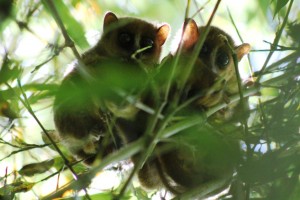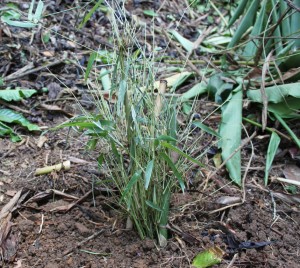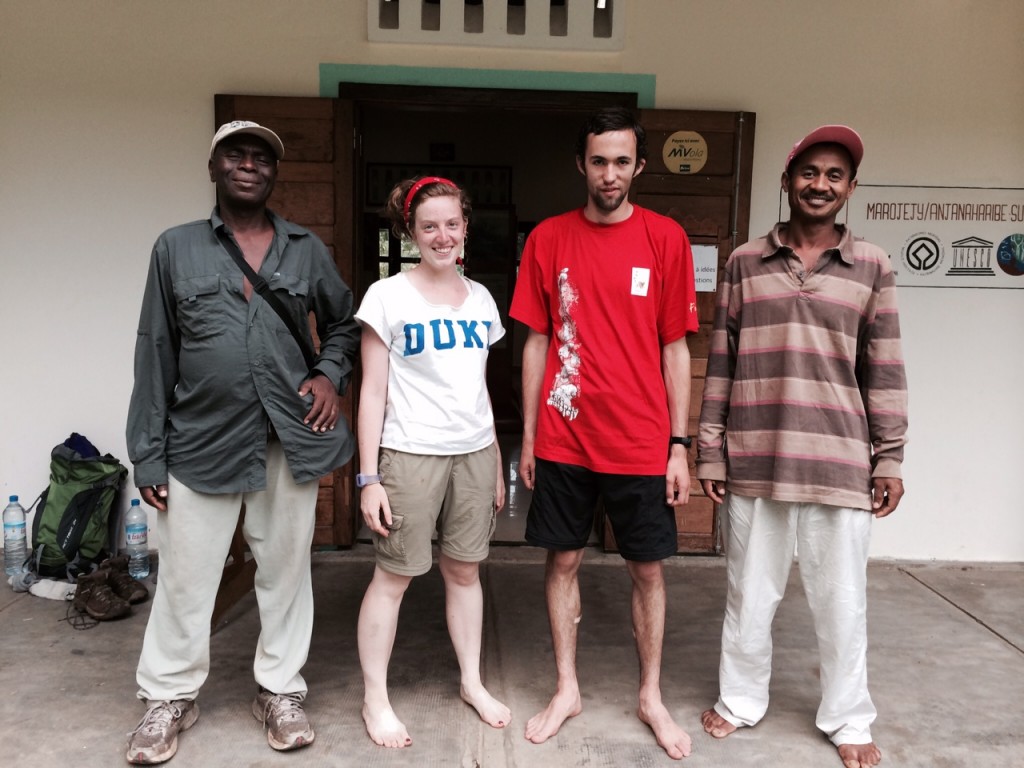June 5, 2014 – Duke students Faye Goodwin and Kyle Smith just wrapped up their third week in Madagascar as part of a two-month service learning project funded by Duke Engage. Read Faye’s ongoing accounts of their adventures in the following post:
Week 2: The adventure continues!
It’s been a wonderful week in Andapa, with two projects under our belt and even some lemur sightings!
Since we wound down the road cut into the thick green mountains to wildlife sanctuary founder Désirè Rabary’s comfortable house in Matsobe, our little tents and Valerie’s warm kitchen have become like home, not to mention the red clay slopes and shady trails of Antanetiambo, our favorite “little hill.” Our first two projects were flagging trails in Desire’s 35-acre nature reserve, and then creating botanical plots. Both helped us get acquainted with the reserve and had us climbing up and down that little hill all day, usually damp with either rain or sweat. Antanetiambo is a chunk of rainforest surrounded by rice paddies and cloudy mountains. On a typical morning we would ride bikes down the busy dirt road to the forest (after tricking Puppy into not following), carry the bikes across a muddy rice paddy under the watchful eyes of the zebu, and enter the forest for a 6-8 hour day (including, of course, a leisurely lunch of leftover rice in the shade of wild ginger and banana trees).
We marked about 30 trails both for tourism and monitoring, hopefully useful in keeping locals in search of building material or protein away from the forest, keeping tourists on track and noting the closest access points to lemur hotspots. We’ve already seen groups of tsidy (mouse lemur) and bokombolo (bamboo lemur) and have marked their locations on our GPS, as well as when they are seen and what they are eating. Our second project, the botanical plots, is intended for a visiting botanist to come and identify all of the species they contain. Knowing both the scientific and local names for these plants, their frequencies and locations will help us understand the nutritional ecology of the lemurs, and guess which spots they might choose to feed. In the case of a plant named Valiha diffusa, a lemur favorite, there is not much in the reserve—at least until now.
Some of our new friends and SAVA workers Ramichel, a park ranger, and Nadege, the librarian, worked hard to plant over 70 new Valhia diffusa in the reserve to supplement bamboo lemur diets. We are so proud of their work and plan to monitor the plots closely for survival (and consumption!)
The projects in Antanetiambo will continue, but after a week of work it’s high time for a vacation. In less than 12 hours our group will set out to climb Marojejy, a 2,132-meter mountain park where the SAVA conservation project with Erik Patel has done amazing work with Silky Sifakas. We will embark on a five-day climb to the summit, hopefully see some silkies and collect some climate data along the way. If I live through my first real mountain climb in years, the next stop is the fish harvest! A great new project for protein availability in the SAVA region is the development of sustainable fish ponds. Later this week the ponds will be harvested and fish censuses will be done to determine success rates, 75% of the fish will be sold for food, and 25% will be re-released into local rivers and streams.
I can’t wait to write about the success of the fish harvest, new lemur sightings, and my inevitable heart attack/leg failure/general failure in climbing Marojejy. Velooma till then!
 Faye is a junior at Duke University and a docent at Lemur Landing. She’s studying environmental science and performance art, and spends her free time onstage, at the Duke Lemur Center, or baking goodies.
Faye is a junior at Duke University and a docent at Lemur Landing. She’s studying environmental science and performance art, and spends her free time onstage, at the Duke Lemur Center, or baking goodies.




